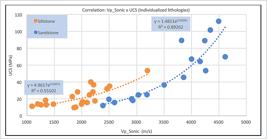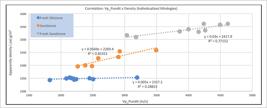Abstract
Knowledge of the physical properties of rock masses is fundamental for the economics and safety of mining projects. The determination of these properties in rock samples in the laboratory requires time, expensive equipment and qualified personnel, which considerably increases the information's cost. Indirect methods were developed to obtain properties related to rock masses, which have been shown to be a viable alternative to traditional procedures. The determination of the compressional mechanical wave velocity (Vp) and subsequent correlation with lithological mechanical properties are indirectly obtained. This study’s objective was to obtain correlations between Vp and the resistance to uniaxial compression, UCS (Unconfined Compressive Strength), as well as the density and porosity of the siltstone and sandstone lithologies present in the coalfield of Candiota, located in the southern region of Rio Grande do Sul, Brazil. The Vp records were obtained in laboratory samples, using ultrasonic velocity sensors, and in-situ by geophysical well logging (directly in boreholes). The results indicate the possibility of using Vp to determine the physical parameters of the investigated lithologies. In the specific case of the correlations between Vp and Unconfined Compressive Strength, determination coefficients R2 above 0.70 were obtained, indicating sufficiently high reliability for using this information (e.g. in roof support projects). The correlation between Vp and density was also high.
Keywords:
sonic logs; p-wave velocity; uniaxial compression strength

 Thumbnail
Thumbnail
 Thumbnail
Thumbnail
 Thumbnail
Thumbnail
 Thumbnail
Thumbnail
 Thumbnail
Thumbnail
 Thumbnail
Thumbnail
 Thumbnail
Thumbnail
 Thumbnail
Thumbnail
 Thumbnail
Thumbnail
 Thumbnail
Thumbnail
 Thumbnail
Thumbnail
 Thumbnail
Thumbnail











